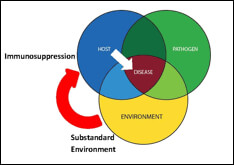Academy Contributors
Turning Challenges into Opportunities: the Principles of Constructive Engagement
 By James F. Gesualdi By James F. Gesualdi
To keep ahead, each one of us, no matter what our task, must search for new and better methods for even that which we now do well must be done better tomorrow.
—James F. Bell
Responsibility for the animals entrusted to our care (as well as those in the wild) presents innumerable challenges. Some of these are the everyday—but never unimportant—sort involving matters of care, housing, treatment, and welfare. There could also be a rare but serious animal-related incident. Others seem to arise outside of ourselves, and perhaps even our zoological organizations. These could include visitor behavior, publicly expressed or reported concerns (most notably, anything relating to animal welfare), regulatory considerations (possibly consisting of purported noncompliant items noted in an Animal Welfare Act inspection report), and perhaps even something like a complaint or harsh externally driven criticism (whether centered on tangible things or "philosophical" ones).
Examining this broad range of potential challenges, representative of the universe of such situations, can make or break us—and our organizations—and even impact the animals in our care. As always, our attitude or consciousness is an indispensable element of our effectiveness. Our attitude and consciousness determine the quality of the transformative actions we can take to resolve challenges, grow from them, and use them as opportunities to better serve animals. Two categories of transformative action are: how we handle ourselves, and the manner in which we interact with and engage others. The former is our focus here, whatever the situation. Taking responsibility starts with us, because that is all we can control. True professionalism involves being accountable, which in turn unlocks our great potential to make things better.
The Principles of Constructive Engagement
It only took me a quarter of a century to discover this approach for elevating my consciousness and making a difference. Here is how to initiate constructive action in the face of any challenge:
1. Think about ways in which you can improve, and how the situation can be used to help animals. Consciously examining how one can improve and intentionally seeking ways to use the situation to help animals puts you in the best possible frame of mind and, with persistence, unlocks ideas for improvement. With practice, the ideas and potential improvements just keep getting better. (Of course, it is helpful to have an accurate and honest sense of the causes underlying the challenge.)
2. Make those ideas even better (collaboratively whenever possible), and put the best ones into a plan. Take the ideas, apply the Beatles' advice in the song "Hey Jude" and "make it better," collaboratively when possible. The best ideas should be combined into a plan of action.
3. Take action (collaboratively whenever possible). Act on the idea or plan. Make it happen—collaboratively if possible.
4. Keep thoughts and actions focused solely on getting better and helping animals. Remind yourself of this constantly. Focus on getting better and serving animals.
5. Be grateful that you can change yourself for the better and, in doing so, help animals. We are all very fortunate to be able to use and improve ourselves in order to better serve and help animals. Be ever grateful, continuously improve, and make an even greater difference in serving animals and their interests.
© 2015 James F. Gesualdi, P.C. The opinions expressed herein are solely those of the author. This is not, nor should it be construed as, legal advice.
Please email me at jfg@excellencebeyondcompliance.com to share the good you are doing (as only you can), or with any comments or questions on this column or suggestions for future ones.
For more information on EXCELLENCE BEYOND COMPLIANCE® see the website.
To order the ebook, click here.
For upcoming workshops and sessions, contact info@excellencebeyondcompliance.com.
The Aquarium Vet
Something Fishy Is Going On
By Dr. Rob Jones, "The Aquarium Vet"
It was terrific to meet many of you at the AZA Annual Conference in Salt Lake City. We have previously talked about the model of disease developed in 1974 by Snieszko. According to Snieszko, disease results from the interplay of three factors:
- Host
- Environment
- Pathogen
Last month, we discussed how a substandard environment, for whatever reason, places the fish under stress. This leads to an increase in cortisol, a natural hormone produced by the fish. This process, in turn, causes immunosuppression, which can suddenly cause typically innocuous bacteria that are normally present in the environment to cause disease and even death (see diagram) in the host animal.

What are these environmental factors? By far the most important is water quality. In real estate, the saying is that there is nothing more important than "location, location, location." In fish keeping, it is "water quality, water quality, water quality." Maintain excellent water quality, and you will prevent up to 90 percent of fish health problems.
The most important parameters within the fish's environment are the nitrogenous compounds (ammonia, nitrite, and nitrate). Ammonia is produced by fish as waste metabolite from the digestion of protein. Fish generally have high dietary protein requirements. Fish excrete ammonia, which in the biofilter (via nitrifying bacteria) is then converted to nitrite and finally nitrate.
The nitrate comes late in this process. It is broken down to nitrogen gas by denitrifying bacteria. This whole process, called the nitrogen cycle, was covered in an Academy webinar I presented last year. To review all the information presented in this hour-long webinar, go to the Academy Course Catalog; under Browse by Category, scroll down to Pre-Recorded Webinars; then locate "The Nitrogen Cycle and Biofiltration."
Other water quality factors that need to be monitored and maintained within the narrow parameters appropriate for the species of fish being displayed include:
- Temperature
- Oxygen
- pH
- Salinity (primarily for marine or brackish-water fish)
- General hardness (primarily for freshwater fish).
In future newsletters, I will examine many of these topics in detail. Several other environmental factors besides water quality are vital for keeping the stress level of the fish in our displays to an absolute minimum. These will be covered next month.
Reference:
Snieszko, S.F. 1974. The effects of environmental stress on outbreaks of infectious diseases of fishes. J Fish Biol. 6, 197-208.
E-quarist™ Courses—Academy Subscriber Special!
The San Diego Zoo Global Academy is excited to share an additional Academy subscriber benefit regarding our collaboration with Dr. Jones: as an Academy subscriber, you are now entitled to a discount on the e-quarist™ courses.
For more information about the SDZGA discount, contact katrina@theaquariumvet.com.au
Visit the Aquarium Vet website at www.theaquariumvet.com.au
|